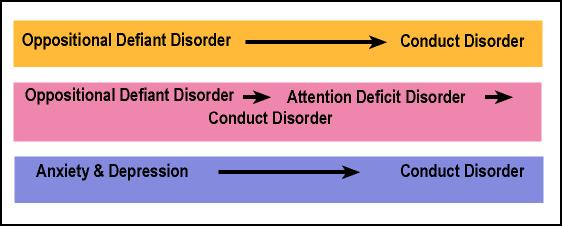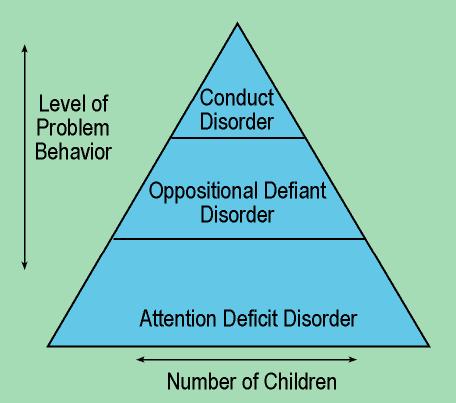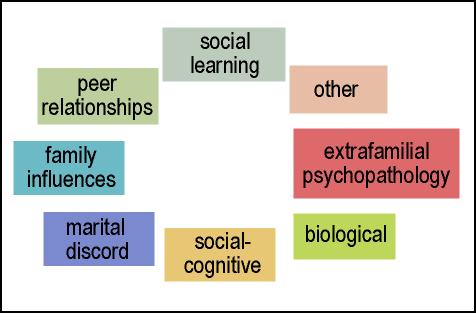| ESE424 : The Class : Mild Disabilities : Behavioral/Emotional : Conduct Disorders | |||||
Conduct Disorders
What are conduct disorders?
Before we begin, it is important to make a differentiation between inattention, impulsivity, and hyperactivity (ADHD/ADD) and conduct problems. These conditions are frequently discussed interchangeably yet they are very different. The term conduct disorder (CD) is used to describe a group of externalized, aggressive and antisocial behaviors. A CD is typically defined by the signs and symptoms that the child displays.
Conduct disorders may include an oppositional defiant disorder (ODD) or this condition may be a related or precursor condition to a CD. Children with an ODD are typically called "noncompliant" or "disruptive." ODD is a less skilled and excessively oppositional behavior that can lead to a later CD. An ODD must be judged to be occurring more frequently than is typical for a child of the same age, culture, and environmental circumstances.
ADHD, on the other hand, refers to a cluster of inattentive and hyperactive behaviors. Since we will be devoting an entire unit to ADD/ADHD, I will not go further into this disability at this time. Be aware that children with ADHD are sometimes identified as having a serious emotional disturbance if symptoms of either CD or ODD are present also.
We should note that IDEA does not use this term. In fact, some would argue that according to IDEA, these types of children are not eligible for special education services at all. If you remember, IDEA specifically excludes children who are socially maladjusted unless they have an emotional disturbance. In reality, however, many children who are served under the diagnostic label of "severe emotional disturbance" have behaviors that are called "acting out behaviors" which are very similar to conduct disorders. Therefore, we will spend our time in this online lesson exploring conduct disorders, associated conditions, and potential causes of conduct problems.
Patterns of Co-occurrence between CD, ODD, and other emotional disorders.
From the results of several research studies, community surveys, and various clinical reports, there are patterns of CO-occurrence of CD with other emotional and behavioral disorders. Click on each of the patterns below to learn more about these relationships.

The CO-Occurrence of ADHD and Disruptive (ODD, CD) Behaviors
Common Patterns of CO-occurrence (go about 1/2 way down the page to the section that presents cases of children with a CD and another condition)
Is a child's ODD a precursor to CD?
Given this information, we could construct a tentative model of CD that might look like this:

Epidemiology of Conduct Disorders and Oppositional Defiant Disorder
Aggression, antisocial responses, and oppositional behaviors are some
of the more common childhood problems. Studies of community samples and
clinical populations show the following facts:
- overall estimates of CD range from 4-10% of the general population.(Rutter, Cox, Tupling, Berger, & Yule, 1975)
- community samples show a prevalence rate of 2-10% of children have some marker signs of ODD or CD (Costello, 1990)
- ODD = 6-10%
- CD = 2-9%
- The ration of males to females is close to 4:1 (Earls, 1994)
- prior to preschool, boys and girls do not differ in the level of conduct problems. However, by the age of 4, boys exhibit a significantly higher level of CD than girls (Keenan & Shaw, 1997)
- Children ages 13-18 show a higher rate of antisocial behaviors (Feldman, Caplinger, & Wodarski, 1983)
Developmental Pathways for Conduct Disorders
It appears that, once evident, some conduct disorders are relatively stable across time. Researchers suggest that up to 10% of children who demonstrate conduct disorders before the age of 5 will continue to do so as adults (Moffitt, 1993). A variety of studies have also shown that the early presence of a conduct disorder appears to be related to later aggressive and antisocial behaviors. Yet, although there are substantial correlations between early onset conduct disorders and later adult conduct problems, not all children that show signs of conduct disorders continue to do so as adults. In a recent study, Campbell (1997) found that only 30-50% of preschoolers who demonstrated conduct problems continued to meet the criteria for externalized behaviors (e.g., aggression) when they enrolled in school. What predicts later conduct disorders? What is the developmental course of a conduct disorder?
Unfortunately, the answer is not simple. Loeber & Hay (1994) have provided us with a model for viewing how people may develop more serious problem behaviors (ODD and CD). This model suggests that less serious behaviors will precede more serious behaviors. Children do not just begin to engage in violent acts. Rather, the end result (serious conduct problems or defiance) is the result of a progression from early problem behaviors to later difficulties and is a progressive diversification of more and more antisocial behaviors. Rather than view this progression as a single pathway, Loeber & Hay propose that there are three pathways to serious problem behaviors. These are:
The Loebel and Hay model is helpful in viewing conduct problems as a developmental progression rather than as an end in and of itself. Two other important findings highlight a developmental path toward conduct disorders
- early onset of conduct disorders is associated with a more serious and persistent course of antisocial behaviors
- adults with chronic antisocial and conduct behaviors frequently began to have difficulties early in life (life-course conduct disorders)
- only 3-5% of the population will have adult conduct disorders
- late onset conduct disorders are the more common pathway
- adolescents who follow this pathway exhibit less severe problem behaviors and tend to be less aggressive.
Research on developmental pathways is relatively new. While we have some information to begin to investigate how children develop serious conduct problems and antisocial behaviors, the database is relatively small and should be viewed as preliminary rather than complete.
Etiology of Conduct Disorders
Research has yet to uncover a clear etiology for conduct disorders. Most likely this cluster of disorders is complex, and has multiple, interrelated potential causes. Some of the prospective causes include:
- aggression as a learned response
- family influences
- extrafamilial variables
- marital discord
- peer relations
- social-cognitive influences
- biological influences
Click on each potential factor to learn more.

Other important research about conduct disorders
Several studies have shown that conduct disorders are related to reading difficulties, substance abuse, and influence later life opportunities
Treatment Approaches
Treatment approaches for conduct disorders and oppositional defiant disorders are many and varied For a review of current approaches to treating conduct disorders, visit each site below..
Promising Treatment Approaches for Conduct Disorder
Once you have finished you should:
Go on to Activity
4: Social Learning Theory and Aggression
or
Go back to Emotional
and Behavioral Disorders
E-mail Larry Gallagher at Larry.Gallagher@nau.edu
Copyright © 2000 Northern Arizona
University
ALL RIGHTS RESERVED


